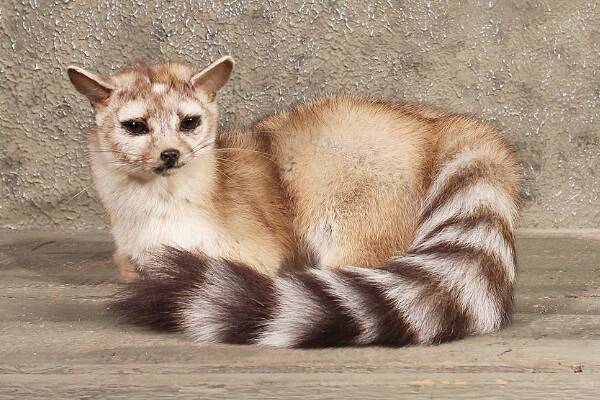Bassariscus astutus
IUCN
LCBasic Information
Scientific classification
- name:Bassariscus astutus
- Scientific Name:Bassariscus astutus,Ring-tailed cat,Ringtail Cat
- Outline:Carnivora
- Family:Procyonidae
Vital signs
- length:30-42cm
- Weight:824-1338g
- lifetime:7-16years
Feature
The cat is named "ringtail cat" because of the 14 to 16 black and white rings on its tail.
Distribution and Habitat
Raccoons are widely distributed in southern North America.
Raccoons live at altitudes of 0 to 1,400 meters, with a maximum record of 2,900 meters. They choose a variety of habitats, preferring to nest in rocky outcrops, canyons, cliff slopes, and food-rich riverbanks. They can also be found in semi-arid areas, deserts, jungles, oak forests, four-needle pine forests, juniper forests, and mountain pine and cypress forests.
Appearance
The weight of both sexes in the distribution area of the raccoon ranges from 824 to 1,338 grams. The head and body length is 305-420 mm, the tail length is 310-441 mm, and the shoulder height is about 160 mm. The upper body is light yellow to dark brown, the lower layer of fur is gray, the lower body is grayish yellow, and the tail fur is dense with black and white rings. The face is grayish white with large white patches, and the outer circle of the eyes is black or dark brown. The muzzle is pointed and long, the whiskers are well-developed, the ears are large and oval, and the ear tips are white. The claws are semi-retractile. There are 40 teeth (the number of upper and lower incisors, canines, premolars, and molars on one side), and the canines are well-developed.
Details
The Ring-tailed cat (scientific name: Bassariscus astutus) is also known as the Ring-tailed cat because of the 14 to 16 black and white rings on its tail. It is particularly good at catching mice, so it is loved by humans and many people keep it as a pet.

Raccoons are usually active late at night and occasionally appear at dusk. They spend most of their time looking for food, and after a full meal, they use a cat-like posture to comb their hair while squatting. They are used to licking their front paws and fur, and then wipe their face, nose and ears with the licked front paws. They are good at climbing and have several methods of coordinating behavior and body movements. They can flexibly bounce back and forth between cliffs and reefs. In small cracks, they use their limbs to support the front wall and move upward with their backs against the back wall. When descending vertically, they face forward and quickly rotate their hind legs 180 degrees, and keep the pads and claws under their feet in contact with the supporting surface for a long time to use the force to jump.
Except for the mating season, the raccoon lives alone, and its activity range can reach 136 hectares. Males generally have a larger activity area than females, and the activity areas of the same sex do not overlap.
The raccoon is an omnivore, preferring animal meat. The choice of specific food depends mainly on the abundance of each season. The staple food includes: rodents, rabbits, squirrels, insects, birds, lizards, snakes, frogs and carrion; plant-based vegetarians include acorns, mistletoe, juniper berries, persimmons, wild figs and other fruits, and sometimes nectar. When threatened, the tail hair stands upright and arches toward the head, making itself look huge. If caught, it screams loudly, accompanied by a piercing sound and emitting a pungent odor.
Females are in estrus once a season, usually mating from February to May, and mating lasts 24 to 36 hours. The gestation period is 51 to 54 days, and births usually occur in May or June, with 1 to 4 pups per litter. Females build nests in rock crevices, pebble piles and tree holes, where they reproduce. Newborn cubs weigh 25 grams and mature late, opening their eyes in about a month. Cubs can eat solid food at 30 to 40 days old and are weaned at about 10 weeks. The female is mainly responsible for taking care of the cubs. When they are 2 months old, the female accompanies the cubs to forage. When they are older, males are occasionally allowed to play with the cubs. Regardless of gender, both sexes mature at about 10 months. Wild raccoons have a lifespan of more than 7 years, and the highest record in captivity is 16 years old.
The raccoons and the same genus raccoons are similar in appearance, which often causes confusion. The main difference between the two is that the claws of the raccoons cannot be retracted, the color of the tail gradually fades, and the ear outline is sharper.
The population density of the raccoon has always been low and is considered a rare species. The survey data of population density are listed as follows: 10.5~20.5/km2 (Belluomini, 1983; Belluomini and Trapp, 1984), 7~20/km2 (Lacy, 1983), 2.2~4.2/km2 (Toweill and Teer, 1980), 0.08-2.3/km2 (Grinnell et al, 1937), 1.5~2.9/km2 (Trapp, 1973, 1978). The population trend is unknown.
Listed in the IUCN Red List of Threatened Species: Least Concern (LC), assessed in 2008.
Protect wildlife and stop eating game.
Maintaining ecological balance is everyone's responsibility!








